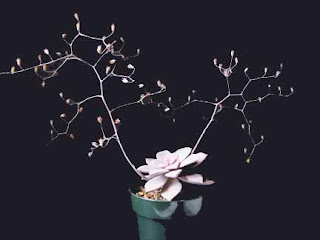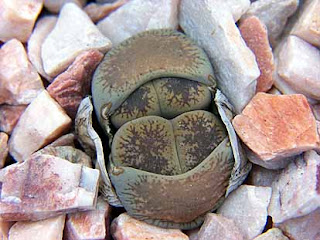Our first Epicactus to bloom this year, it's Piland's Pride, a delicate medium sized flower. It blooms early in the year for us. I was sitting in the greenhouse having an Irish coffee with Lynn-Marie talking about the need to get to watering the Epies, and I looked across the greenhouse and lo and behold! A very pleasant surprise.
Sunday, January 31, 2010
Echeveria 'Blue Waves'
I couldn't help but take a picture of 'Blue Waves' today. One of the many "blue" Echeverias, it's one of the ones which stand out.
Still working on the web pages, so not much time to blog. More later.
Thursday, January 28, 2010
Rebutia narvaecense
Yes, I'm cheating. I didn't take this picture today. I did actually remember to take the camera with me when I was working in the greenhouses today, but it's still out in the greenhouse! So...back to the archives from a photo taken in June of 2008 of Rebutia narvaecense in flower. And I mean in flower!
We've been having some very Fall like weather this week...dry, temps in the 50s (F), but it's far too early to be able to enjoy these flowers this year. The photo will have to do. Tomorrow I'll have some photos from now!
Like most Rebutias, R. narvaecense is quite easy to grow and flower. Good drainage, dry rest period, and normal cactus care in general is all it takes.
We've been having some very Fall like weather this week...dry, temps in the 50s (F), but it's far too early to be able to enjoy these flowers this year. The photo will have to do. Tomorrow I'll have some photos from now!
Like most Rebutias, R. narvaecense is quite easy to grow and flower. Good drainage, dry rest period, and normal cactus care in general is all it takes.
Sorry for the Absence
I will blog some photos tomorrow! I promise. I've been totally tied up trying to get the upgrade for our nursery website completed that I just haven't been getting to the blog.
However we did get out for a drive with Ladybug the mini horse. The weather was just too nice not to get out and enjoy it. Not a long ride...just three miles around the neighborhood. The daffodils and iris are coming up, the "Snowdrops" are blooming, the raspberry vines are beginning their new shoots, and buds are popping up all over in the greenhouse. Yes, yes, yes! Spring can't be far away!
However we did get out for a drive with Ladybug the mini horse. The weather was just too nice not to get out and enjoy it. Not a long ride...just three miles around the neighborhood. The daffodils and iris are coming up, the "Snowdrops" are blooming, the raspberry vines are beginning their new shoots, and buds are popping up all over in the greenhouse. Yes, yes, yes! Spring can't be far away!
Sunday, January 24, 2010
Albuca species
While doing some inventory in the greenhouses today I couldn't help to notice the signs of spring there, as well as outside. Some of the cacti are budding up and the Lithops are continuing with their growth thing. But I couldn't pass by this little gem: an un-named Albuca species from near Dusseldorp, South Africa. (The flower of course is a close-up view.)
Tuesday, January 19, 2010
Bryophyllum daigremontianum - Mother of Thousands
We get more calls about this plant than you can imagine. "My mother had a plant that had these little plants growing along its edge. Do you know what it is?" "My friend gave me this succulent plant that had these funny little leaflets growing along the edge. Can you tell me anything about it?"
The first response of many succulent hobbyists is to say, "You mean that 'Mother of Thousands' weed?" But that's not quite fair. It can be quite charming in its prime. And though it can become a greenhouse weed and it could become very invasive in welcoming climatic zones, in our area it won't overwinter outside. Therefore last year we decided to use it as an annual and it did beautifully, adding an interesting feature to an otherwise drab area. The winter weather has killed all those but - not to fear - we have more, wintering away in a corner of the greenhouse - hopefully as far away from other potted plants as possible....Well, one can hope!
The first response of many succulent hobbyists is to say, "You mean that 'Mother of Thousands' weed?" But that's not quite fair. It can be quite charming in its prime. And though it can become a greenhouse weed and it could become very invasive in welcoming climatic zones, in our area it won't overwinter outside. Therefore last year we decided to use it as an annual and it did beautifully, adding an interesting feature to an otherwise drab area. The winter weather has killed all those but - not to fear - we have more, wintering away in a corner of the greenhouse - hopefully as far away from other potted plants as possible....Well, one can hope!
Thursday, January 14, 2010
Lithops karasmontana var. aiaisensis
OK. One more Lithops photo. Not much of a picture though. But it's of a variety we haven't had before, karasmontana var. aiaisensis. After they get their new leaves and have a chance to grow a bit, I'll get a better picture. Until then, this will have to do.
Tuesday, January 12, 2010
Lithops hookeri var. subfenestrata C19
Another photo of Lithops going through the birthing of their new leaves, this time Lithops hookeri var. subfenestrata (ex. C19). But enough for now. I'll come back to the Lithops later in the early Spring.
Lithops fulviceps 'aurea'
And then there's Lithops fulviceps 'aurea', all doing their own thing, in various stages of growth. Irresistible.
Lithops pseudotruncatella groendrayensis
Don't blink. You might miss the growth spurt! All joking aside, the growing continues unabated, each one in its own way. Sort of like children...
Mammillaria formosa - another image
I just couldn't resist posting another picture of Mammillaria formosa. I took my camera out to the greenhouses today to take pictures of the Lithops growing. (I know, about as exciting as watching grass grow!) But along the way I couldn't resist another photo of this group of mams.
Sunday, January 10, 2010
Art by Kara --- "Red Epi"
Time to post another art work by Lynn-Marie. This is a work titled "Red Epi" - original aren't we? - and it's a multimedia piece, with colored pencil, acrylic and collage.
Graptoveria 'Opalina' - Echeveria 'Imbricata' - Echeveria lilicina
Meet Graptoveria 'Opalina', Echeveria 'Imbricata' and Echeveria lilicina. We grow them as potted plants and occasionally as summer bedding plants, but in areas of a warmer climate - imagine the possibilities.
Friday, January 8, 2010
How's that for Owl's Eyes? (Mammillaria formosa)
It's not surprising that this and other similar Mammillarias received the common name of "Owl's Eyes"! There are several ball cacti, especially among the Mammillarias, which are dichotomous and branch, making for an interesting appearance. Lynn-Marie says this plant is just asking for a beak right there in the lower center...
Thursday, January 7, 2010
Graptopetalum pentandrum ssp. superbum
This is another one of those plants whose flowers can't be fully appreciated until you get up close and personal: Graptopetalum pentandrum ssp. superbum. They're a part of the Crassulaceae and are from Mexico. Following are a few photos. (Specific status has been proposed for superbum, but I'm not aware if this has been widely accepted.)
Wednesday, January 6, 2010
Lithops Growing Season
Out in the greenhouses again today I noticed the Lithops. This is a fascinating time for them, as they grow their inner leaves. I didn't have my camera with me so this is a file photo from a previous year. And though we've been growing these little jewels for over 30 years, I'm still amazed at their growth every new year.
Rhipsalis grandiflora
It may not look like much, but I'll take what I can get. It's a sign of Spring to come: Rhipsalis grandiflora beginning to set buds. Along with the "Snowdrops" pushing their little heads up outside, they're harbingers of what we can expect. Every little thing counts!
Monday, January 4, 2010
Stenocactus phyllacanthus
Finally, the last of the Stenocactus series: Stenocactus phyllacanthus. We received it as Echinofossulocactus tricuspidatus, an older name which is now generally accepted to be subsumed under S. phyllacanthus. Very distinctive for the limited number of radial spines and it's small yellowish flowers.
Yesterday evening I spent some time seeding 17 packets of Lithops seeds. Now we wait.
Yesterday evening I spent some time seeding 17 packets of Lithops seeds. Now we wait.
Stenocactus multicostatus
This is the classic Stenocactus multicostatus - the "wave" or "brain" cactus. They're quite variable in habitat and as a result several other species are clumped together in this complex. This particular plant is from seed collected at Los Imagines, Coahuila, Mexico (SB1147) and is an excellent example of the species. They can have as many as 120 ribs, although the 60 or so on this plant is more typical.
Sunday, January 3, 2010
Stenocactus (Echinofossulocactus) crispatus var. xiphacanthus
This is another one in the crispatus complex, var. xiphacanthus. The variety name refers to the lance shaped spines, which make it quite impressive. Culture, like for all stenocacti, is very easy, using basic succulent plant growing techniques. And though I don't have any pictures with flowers here - it's not the right time of year - they are good bloomers!
Saturday, January 2, 2010
Stenocactus crispatus var. longispinus?
Stenocactus crispatus is now considered by the scientific community as a species which has within it a large degree of diversity, creating what Anderson called "a taxonomic nightmare." This means that it now includes a large number of former species and that the varietal status of this plant is questionable. But for the collector, a notation that this is a "long spined form" is probably helpful. Perhaps Stenocactus crispatus (long spines). But whatever you call them, they're real beauties.
Subscribe to:
Comments (Atom)

























